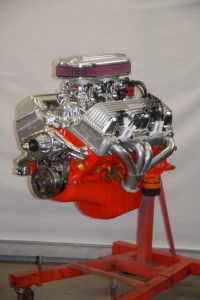Chevy’s 348 and 409 ‘W’ motors are having no problem keeping their popularity going. In fact, judging by the numbers of high quality parts being made for these motors today, they may even be more popular than ever. The quick and dirty of W motors and their parts today is that you can sit at your computer, whip out your credit card and ‘build’ a 409 without having to buy one original part.
While that in itself is pretty mind blowing, you also have the option to build a 509 or even a 609-inch W motor. So, it makes perfect sense that with all those parts, there are a surprisingly high number of stroker combos available.
W Origins
Chevy’s W-series 348 and later the 409 became legends on the street, and in particular the 409 also became a legend on the track. In the early 1960s, these engines powered a variety of GM vehicles and the Z-11 Impalas at the drag strip. While these engines enjoyed a hay day in the early 1960s and pop culture status in the hot rod community, higher horsepower Mark IV Chevy big-block engines overshadowed these W-engines by the late 1960s. But recently, the 348s and 409s have enjoyed a high-performance renaissance and many speed manufacturers are making heads, blocks and virtually every part for these engines.
Half and Half
A quick history lesson shows us that Chevy used stroking to grow the 348 into the 409. One half of the move from 348 to 409 was an increase of .1875 inches in the cylinder bore. A stock 348 has a bore of 4.125 inches and a 409 has the bigger bore of 4.3125 inches. The other half was the stroke change from 348s to 409s that went from 3.25 to 3.50 inches for a net gain of a quarter inch. Together, the new bore and stroke gained those 61 cubic inches.
Chevrolet made fewer than 50 of the Z11 engine for drag racing. The engineers stroked out the 409 into 427, increasing the size of the engine by lengthening the stroke of the rods and not overboring the cylinders.
Of course, there was more to do such as redesign the block for both clearance and better water flow. But, the basics are still the same.
Chevy did it one more time when they created a handful of motors used exclusively for drag racing in late ‘62/early ‘63. Those motors would turn out to be the Holy Grail of W engines, the rare Z-11, 427 cubic inch motor. They’re also a good example of how stroker methodology works. To make the Z-11 427, Chevy actually used a standard 409 block with its stock bore of 4.3125 inches.
Because the W motor was pretty much ‘capped’ at that size and could not physically go much larger, any additional cubic inches would have to come from increasing the stroke. Chevy did just that and added .150 inches to the stock 409 stroke, for a 3.650 inch stroke.
Of course, a newly-designed set of iron heads and aluminum intake let those extra 18 inches breathe much better and become a legend in the Super Stock wars.
427 Version
Along the lines of Z11 specs, noted 409 guru, Lamar Walden, tells us a homemade version of the famous Z11 short block can be simply made by using that same 3.650 stroke crankshaft in a stock 409 block with a stock bore size. No extra crankshaft clearance work is needed on the block and all the bearing sizes are the same so it becomes a ‘drop in.’
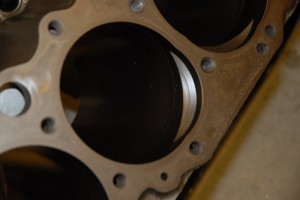
When rebuilding W engines, care must be taken that the compression is correct. Here you can see the relief cut is actually two cuts. These cuts are still used today, even when overboring the blocks to create a bigger engine.
The final results will yield a 427 cubic inch W motor with your choice of heads and intake.
Below the Block
Another aspect dealing with the increased crankshaft clearance required with building a W stroker engine goes beyond the block – or more accurately, below the block. The oil pans from 348 and 409 motors have an interchangeable bolt pattern, but are different.
While that may sound confusing, think of it this way. The oil pan of a 348 can’t always be used on a stroker motor as it is slightly narrower than those made for 409s. The answer is to use the wider 409 oil pan or, as Joe Jill from Superior Automotive says, “notch the 348 pan.”
With today’s generous amount of reproduction 348/409 parts available, a factory reproduction 409 oil pan can be easily found at places like Show-Cars.com. Racing oil pans for W motors can be found at Stef’s Performance Products.
Building Strength
Another related aspect to stroking any W motor is making it stronger. Most builders will agree that if having some machine work is in the cards for any W stroker, it is an excellent time for an additional machine operation. All W motors came with only two bolt mains.
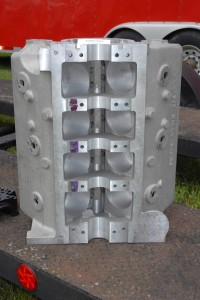
At the bottom of this Bob Walla block, you see strong cylinder walls, cross webbing and plenty of clearance for stroker engines.
Today, we know four bolt mains are desired in virtually all racing engines, and all of the new, aftermarket aluminum and iron blocks use them on the center three mains. Retrofitting a 348 or 409 block to use four bolt mains on those center three mains is not difficult and the block offers room for the upgrade.
There are a number of companies making retro fit caps and a choice of straight or splayed is available.
One such company is Pro Gram Engineering, which makes three such products. One is with the extra bolts being added in a straight pattern. Another uses a splayed pattern and the third offers a front cap with four straight bolts. These kits fit both the 348 and 409 blocks as both use the same diameter cranks.
Formula 409
If a builder wants a monster motor with lots of cubic inches, the best way would be to use one of the new aluminum 409 blocks by World Products or Bob Walla Racing.
Walla also offers iron blocks and we’ll get back to that shortly. With these new aluminum and iron blocks, much larger motors can be built without any of the original engine’s design limitations.
The early test motors built using the all aluminum World Merlin 409 easily made over 500 inches, settling in at a comfortable 509 cubic inches under the talented hands of Lamar Walden, who designed the blocks for World. If that isn’t enough cubic inches for a W motor fan, Bob Walla’s iron block is capable of housing 600 or 609 cubic inches.
These are essentially stroker engines as the stroke and bore offer seemingly unlimited combos.
From the money angle, a W stroker can be built two ways.
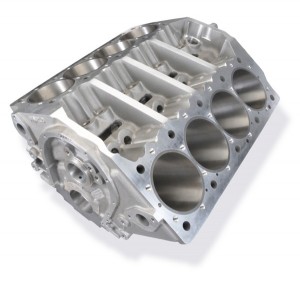
A look from above the World W block shows large ribs that add to the webbing structure to strengthen the block in the lifter gallery area.
One uses a bigger budget for custom made parts, such as those aftermarket blocks using custom made crankshafts, rods and pistons.
The other and more economical way is to use off the shelf parts designed for W strokers using stock blocks. Those parts are steadily growing in numbers and availability.
Many times, stroker kits are available and include the core parts such as crank, rods and pistons. Other kits are more complete and add rings and bearings.
The benefit that is really growing is that many of these kits require little or no machining.
Popular Kits
Lamar Walden Automotive has a few stroker kits for 409s. One is a 450 cubic inch model and the other is a 482 cubic incher – both from 409 blocks.
They include forged pistons, steel crankshaft, H beam connecting rods, rings and bearings.
Show Cars, a specialist for Chevys of that era, sells a 409 four inch stroker kit that comes with an Eagle crankshaft, Ross forged pistons and pins, GM rods, Clevite bearings and a chrome moly piston ring set.
Since they offer a number of stroker kits, the sizes and components vary.
Another Show Cars kit has a 3-3/4 stroke and coupled with bore sixes that are 0.030, 0.040 and 0.060 over, there are varied combinations. 11:1 compression Keith Black pistons have overbore sizes of the slightly different 0.038, 0.048 and 0.068 in. 348s have not been left out as there are kits using the same 3-3/4 stroke and overbore sizes.
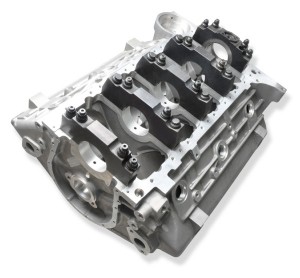
This view of the World aluminum W block shows the steel main caps and distinctive water pump bosses outboard on the face of the block.
Scat Crankshafts is another one offering stroker kits. Its two kits start with 409 blocks and are available in 434 and 472 cubic inch versions using 4.155 and 4.340 bore sizes. Both H and I beam connecting rods are available. The kits include the crankshaft, rods, pistons, rings and bearings, and can be bought with different balancing packages.
For those making their own stroker, Eagle Rods and Crankshafts offers a crankshaft with a four inch stroke for 409s, as well as the rods to fit it. While not a full kit, W pistons can be had by a number of manufacturers.
Don’t forget that BBC crankshafts make the basis of a good W stroker and tapping into companies such as Calles can get you a state of the art model.
Combinations and Calculations
There are a surprisingly large number of stroker combinations using stock 348 or 409 blocks. Steve Magnante is an automotive journalist and has reported on a number of stroker builds. Here’s a few of them, broken down to just the facts for a quick reference.
The Edelbrock 421 Stroker came about when Edelbrock wanted to start building aluminum W motor heads. Edelbrock built this stroker as its test mule, long before any new aftermarket blocks were available.
Starting with a 1964 truck 409 block and crankshaft, the motor’s six quart oil pan, .060” overbore (final bore size of 4.375 inches) and the stock 3.50-inch stroke, the combo ended up as 421 cubic inches.
A four bolt main kit was used as well as 9.6:1 J&E pistons on Eagle forged H-beam rods, and the 6.135 inch long Big Block Chevy pieces that fit the 409 crank perfectly.
Also included were ARP 7/16, 12 point cap rod bolts to improve over the stock 3/8 bolts that Chevy orignally used. All this was designed to allow it to use 91 octane fuel and be a street engine.
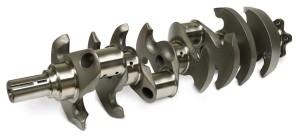
This Magnum XL crank from Callies is offered in a 3.50” to 5.6” stroke for big-inch engines. The 4340 forged steel crankshafts provide ample strength and longevity for these engines.
The crankshaft snout on a W motor will match up to a Small Block Chevy harmonic balancer, so an ATI Super Damper was used.
The intake was an Edelbrock dual-quad aluminum with Edelbrock 500 CFM Thunder AVS carburetors. This combo created 466 horsepower and 461.9 torque.
That in itself is quite a motor and with just the .060” overbore, yet, retaining stock 409 heads. When Magnante reported on this engine, he said more could be built into that 409 truck block, “Step up to a 470-plus cube stroker kit, add a point of compression, swap on a set of 750-cfm carburetors and do a little porting and you’ll nudge 600 horsepower for sure.”
Edelbrock’s recipe yielded horsepower: 466.1 @ 5800 rpm.
Basic specs are:
Block409
Stroke3.500
Bore4.375
Cubic Inches421
HP (approx)466
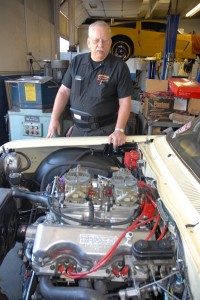
Chevy’s W-series 348 and later the 409 became legends on the street, and in particular the 409 also became a legend on the track.
Another W stroker Magnante reported on also uses a 409 block with a big, four inch stroke and even bigger pistons. In this case, a crankshaft from a Big Block Chevy is the starting point. The bore was .060 over and the results were 481 cubic inches.
Tech wise, the bore ended at 4.3725 inches. Superior Automotive did this build and they used a popular crank for W strokers, the Mark IV, 454 Big Block Chevy.
There is a trick here, as it needs to be a crank from between 1970 and 1990.
Later crankshafts, like 1991 and up, won’t fit into the 409 block. Using this will increase the stroke by ½ inch and, coupled with the bigger pistons and other performance work, will yield 532 horsepower and 542 ft./lbs. of torque.
There are a few machining operations that need to be done on the 454 crank before assembly. The biggest is turning down the mains .250 inch from 2.748 to 2.498 inches.
After machining the mains, the radius on the crank’s journal to the cheek will need to be stress relieved as the new shape will be 90 degrees. Precision balancing is also recommended as is turning down the crank snout.
The finished size should be 1.250-inches so an externally-balanced SBC 400 damper can be used.
Joe from Superior says that in the past, he had to do quite a bit of crankshaft work for his W strokers.
The Superior Automotive 481 Stroker sports the following specs:
Block409
Stroke4.00
Bore4.3725
Cubic Inches481
HP (approx) 532
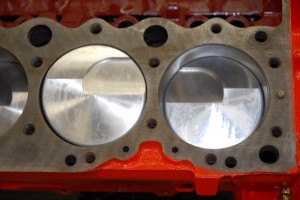
At this stage of the rebuild, the pistons, cam, crank and timing have all been installed and our short block is virtually complete.
Typically, they would need to be turned down, edges rounded and chamfered, counterweights knife edge shaped and snouts turned down.
It didn’t stop there, as there was heat-treating and hard coating to do. Joe says these days, finished stroker crankshafts are more readily available and even offer centralized counterweights so additional clearance is minimal or not even needed.
On this 409/481 build, the added throw of the bigger 454 counterweights and connecting rods are enough to impact the bottom of the cylinder bores.
Machining small notches creates clearance for the now-larger rotating assembly. The rest of the rotating assembly has some wiggle room, too. Superior says reconditioned stock 454 rods can be used, but they opted for new, forged steel, Eagle I-beam rods that are often less expensive.
These rods have the usual 454, 6.135 inch measurement and offer wider beams, wrist pin bushings and use bigger ARP 7/16 inch rod end cap bolts.
Another cool combo came from Superior Automotive, and it was a sleeper!
This stroker takes advantage of the fact that a lot more 348s were made than 409s. In fact, when the 409 came out, Chevy kept making the 348s. Superior says these little brothers can make a kick ass 434 inch stroker.
This combo used Edelbrock’s Performer RPM aluminum heads, an Eagle stroker crank with H-beam rods, Ross pistons, an Isky solid roller cam and a new single plane, four barrel intake manifold from Lamar Walden which developed 576.8 horsepower at 6200 RPM with 516.8 ft./lbs. at 5500 RPM.
According to Superior, the they started with the stock bore and opened it up from 4.125 by 0.030 to 4.155 inches. They checked the wall thickness after the bore and found it to be 0.175 average.
A second boring operation enlarged the crescent found in 348/409 blocks that acts as part of the combustion chambers and that size is now .060” over.
Into the block went an Eagle, 4340 forged steel crank. Even with its four inch stroke 0.750 greater than the stock 3.25 stroke of a 348, Eagle reduced the counterweight diameter of its crankshaft, making it a drop-in.
The Ross forged pistons are 11.7:1 versions and weigh less than the stock pieces and the newer rods are heavier and stronger than the originals. Sometimes with this build, that extra ¾ inch of stroke might contact some 348 blocks, so Superior used its Rottler CNC machine station to add some clearance.
With the use of Edelbrock Performer RPM heads, the valves are bigger than stock and will impact the block if the lift is too great. But that’s more about the aluminum heads than the block.
The Superior Automotive 434
Stroker measures out like this:
Block348
Stroke4.0
Bore4.155
Cubic Inches434
HP (approx)577
The heads are limited by Edelbrock to 0.550 maximum valve lift on 348 blocks. This insures no valve-to-block contact so checking with a spring and dial indicator is suggested.
An easy aspect of this build is that a stock 348/409 crank snout will fit a SBC harmonic balancer. It will need relocating of the timing mark to be accurate. The new Eagle stroker crankshaft corrects this with the correct keyway position.
These are but a few of the options for building a W Motor Stroker out of a stock block.
The aftermarket blocks offer even more combos to build bigger and badder W motors.
Editor’s Notes: The suppliers mentioned in this article are options and recommendations presented by the author for particular stroker builds.
Engine builders should use this information as a reference and that performance results from their own stroker builds will vary, depending on their selection of parts and products.
For a downloadable Stroker Engine Reference Guide of General Motors, Ford and Chrysler kits, visit: www.EngineBuilderMag.com.
The post Chevy’s 348 and 409 ‘W’ Motors appeared first on Engine Builder Magazine.
Read more here: Engine Builder Magazine

